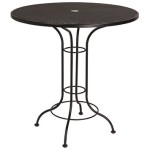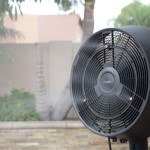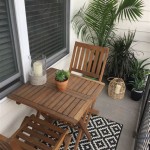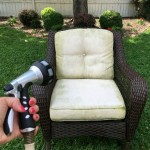```html
How To Clean Your Concrete Patio
Concrete patios provide durable and attractive outdoor living spaces. However, concrete, being a porous material, is susceptible to staining, discoloration, and the accumulation of dirt, grime, mold, and mildew. Regular cleaning and proper maintenance are essential to preserve the aesthetic appeal and prolong the lifespan of a concrete patio.
The frequency of cleaning depends on various factors, including the patio's exposure to the elements, the amount of foot traffic, and the presence of surrounding vegetation. Patios located under trees or in damp, shady areas might require more frequent cleaning than those in sunny, open locations. Generally, a thorough cleaning at least twice a year – once in the spring and once in the fall – is recommended. More frequent cleaning might be necessary if spills occur or if significant staining or discoloration is observed.
Preparation is Key: Gathering Supplies and Protecting Surroundings
Before commencing the cleaning process, proper preparation is crucial. This involves gathering the necessary cleaning supplies and taking precautions to protect surrounding plants, furniture, and other vulnerable surfaces. Neglecting these steps can lead to inadequate cleaning results or damage to adjacent areas.
The required cleaning supplies vary depending on the severity of the soiling and the chosen cleaning method. However, some essential items include a stiff-bristled brush (preferably with a long handle for easier scrubbing), a garden hose with a spray nozzle, a bucket or container for mixing cleaning solutions, and appropriate cleaning agents. The selection of cleaning agents depends on the type of stains or soiling present, and options range from mild detergents to specialized concrete cleaners.
Before applying any cleaning solution, it is important to thoroughly sweep the patio surface to remove loose debris such as leaves, dirt, and twigs. This step prevents the debris from interfering with the cleaning process and allows the cleaning solution to effectively penetrate the stained areas.
Protecting surrounding plants and furniture is essential to prevent damage from cleaning solutions. Cover nearby plants with plastic sheeting or tarps to shield them from potential chemical exposure. Move any patio furniture or decorative items away from the cleaning area to prevent accidental staining or damage. If moving furniture is not feasible, cover it with protective materials.
Basic Cleaning Methods: Simple Solutions for Everyday Dirt
For light to moderate soiling, a simple cleaning solution of soap and water often proves effective. This method is suitable for removing everyday dirt, dust, and minor stains. The process involves mixing a mild detergent with water in a bucket, applying the solution to the patio surface, scrubbing with a stiff-bristled brush, and rinsing thoroughly with a garden hose.
The ratio of soap to water depends on the concentration of the detergent and the severity of the soiling. A general guideline is to use approximately one-quarter cup of mild detergent per gallon of water. It is advisable to start with a weaker solution and gradually increase the concentration if necessary. Overly concentrated solutions can leave a residue on the concrete surface.
When applying the cleaning solution, ensure that the entire patio surface is evenly coated. Allow the solution to dwell on the surface for a few minutes to loosen the dirt and grime. Avoid allowing the solution to dry completely, as this can make it more difficult to remove. Use the stiff-bristled brush to scrub the patio surface in a circular motion, paying particular attention to stained or heavily soiled areas. Apply sufficient pressure to dislodge the dirt and grime, but avoid excessive force that could damage the concrete.
After scrubbing, thoroughly rinse the patio surface with a garden hose, using a spray nozzle to ensure that all traces of the cleaning solution are removed. Residual soap or detergent can attract dirt and grime, negating the cleaning efforts. Inspect the patio surface to ensure that all stains and soiling have been removed. If necessary, repeat the cleaning process for stubborn stains.
For mold and mildew removal, a solution of bleach and water can be used. However, caution is advised when using bleach, as it can damage plants and discolor certain surfaces. The recommended ratio is one part bleach to ten parts water. Apply the solution to the affected areas, allow it to dwell for 10-15 minutes, and then scrub with a stiff-bristled brush. Rinse thoroughly with water, taking care to avoid contact with plants and other sensitive materials.
Alternatively, commercial mold and mildew removers specifically formulated for concrete are available. These products often contain less harsh chemicals than bleach and may be a more environmentally friendly option. Always follow the manufacturer's instructions when using commercial cleaning products.
Dealing with Stubborn Stains: Specialized Cleaning Techniques
Stubborn stains, such as oil, grease, rust, or tannin stains from leaves, may require specialized cleaning techniques and stronger cleaning agents. Identifying the type of stain is essential for selecting the appropriate cleaning method. Attempting to remove a stain with an ineffective cleaning agent can be time-consuming and may not yield satisfactory results.
Oil and grease stains are common on concrete patios, particularly in areas where grilling or outdoor cooking occurs. To remove oil and grease stains, apply a degreasing agent specifically designed for concrete. These agents work by breaking down the oil and grease molecules, making them easier to remove. Follow the manufacturer's instructions for application and dwell time. After the degreasing agent has been allowed to dwell, scrub the stained area with a stiff-bristled brush and rinse thoroughly with water.
For rust stains, a rust remover containing oxalic acid is often effective. Oxalic acid reacts with the rust, converting it into a soluble form that can be easily washed away. Apply the rust remover to the stained area, allow it to dwell for the recommended time, and then scrub with a brush. Rinse thoroughly with water. Caution is advised when using oxalic acid, as it can be corrosive and may damage certain surfaces. Always wear protective gloves and eyewear when handling oxalic acid-based products.
Tannin stains, caused by decaying leaves or other organic matter, can be removed with a solution of trisodium phosphate (TSP). TSP is a strong alkaline cleaner that can effectively remove organic stains. Mix TSP with water according to the manufacturer's instructions and apply the solution to the stained area. Allow it to dwell for 15-20 minutes, then scrub with a brush and rinse thoroughly with water. TSP can be harmful if ingested or inhaled, so it is important to wear protective gloves and a respirator when using this product.
Pressure washing can be an effective method for removing stubborn stains and deeply embedded dirt from concrete patios. However, it is important to use caution when pressure washing, as excessive pressure can damage the concrete surface. Use a wide-angle nozzle and maintain a safe distance between the nozzle and the concrete surface. Avoid using concentrated streams of water on delicate or decorative concrete surfaces.
Before pressure washing, it is advisable to pre-treat the stained areas with a cleaning solution to loosen the dirt and grime. This will enhance the effectiveness of the pressure washing process. After pressure washing, inspect the patio surface to ensure that all stains have been removed. If necessary, repeat the process or use specialized stain removers for any remaining stains.
```
Best Way To Clean A Concrete Patio Chalking Up Success

How To Clean Concrete The Easy Way Porches Patios Driveways More Run Radiance

Diy Miracle Concrete Patio Cleaner I Should Be Mopping The Floor

Diy Miracle Concrete Patio Cleaner I Should Be Mopping The Floor

How To Clean Concrete The Easy Way Porches Patios Driveways More Run Radiance

The Easiest Way To Clean A Concrete Patio My Creative Days

Diy Miracle Concrete Patio Cleaner I Should Be Mopping The Floor

Diy Concrete Patio Cleaner Based On Science Chemistry Cachet

How To Clean Patio Slabs Minster Paving

How To Clean Concrete Professional Pressure Washing Vs Diy Washh








